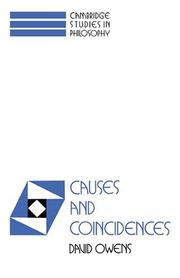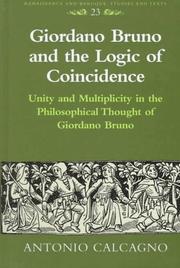| Listing 1 - 3 of 3 |
Sort by
|

ISBN: 0521416507 0521044480 0511520069 Year: 1992 Volume: vol *14 Publisher: Cambridge : Cambridge University Press,
Abstract | Keywords | Export | Availability | Bookmark
 Loading...
Loading...Choose an application
- Reference Manager
- EndNote
- RefWorks (Direct export to RefWorks)
In an important departure from theories of causation, David Owens proposes that coincidences have no causes, and that a cause is something which ensures that its effects are no coincidence. In Causes and Coincidences, he elucidates the idea of a coincidence as an event which can be analysed into constituent events, the nomological antecedents of which are independent of each other. He also suggests that causal facts can be analysed in terms of non-causal facts, including relations of necessity. Thus, causation is defined in terms of coincidence, and coincidence without reference to causation. David Owens challenges the ideas associated with Hume, Davidson and Lewis, constructing a theory which distinguishes nomological necessity and sufficiency from their logical counterparts. He is able to offer novel solutions to the major problems of causation, including the direction of causation, the logical form of causal statements, the distinction betwen causal connections and logical connections, and the relationship between psychological and physical causation.
Causaliteit --- Causalité --- Causation --- Coincidence --- Gelijktijdigheid --- Oorzakelijkheid --- Simultanéité --- Coïncidence --- Simultaneousness --- Synchronicity --- Synchronism --- Chance --- Simultaneity (Physics) --- Causality --- Cause and effect --- Effect and cause --- Final cause --- Beginning --- God --- Metaphysics --- Philosophy --- Necessity (Philosophy) --- Teleology --- Causation. --- Coincidence. --- Causalité --- Coïncidence --- Arts and Humanities
Book
ISBN: 3658142278 3658142286 Year: 2016 Publisher: Wiesbaden : Springer Fachmedien Wiesbaden : Imprint: Springer,
Abstract | Keywords | Export | Availability | Bookmark
 Loading...
Loading...Choose an application
- Reference Manager
- EndNote
- RefWorks (Direct export to RefWorks)
Morten Frederiksen explores Carl Gustav Jung’s elusive notion of synchronicity from a transrational perspective and relates synchronicity to the transpersonality of the "All-One". This is done by expanding the content and meaning of Wolfgang Dietrich´s layers of Elicitive Conflict Mapping (ECM) through re-relating them to Ken Wilber´s model of the structures of consciousness; with synchronicity as the literal connecting principle. The result, then, is an expanded notion of the transrational peace philosophy which includes Wilber´s model of stages shorn of its evolutionary slant and fathoms synchronicity in its theoretical outlook and practical application. Contents A Transrational Approach to Peace Studies through processing the Topic of Synchronicity Jungian Psychology and his Concept of Synchronicity Transrational Peace Philosophy and Consciousness Development Seven different Structures of Consciousness Consequences of Synchronicity for a transrational-oriented Peace Philosophy and Practice Target Groups Lecturers and Students of Psychology, Peace Students and Conflict Transformation Researchers Practitioners in the Field of Elicitive Conflict Transformation About the Author Morten Frederiksen is a Peace Researcher from the MA Program in Peace, Security, Development and International Conflict Transformation at the University of Innsbruck, Austria, and Coordinator of the Danish Development Aid Agency "U-landsforeningen Svalerne".
Psychology. --- Developmental psychology. --- Supervision. --- Counseling. --- Developmental Psychology. --- Consulting - Supervision - Coaching. --- Coincidence. --- Simultaneousness --- Synchronicity --- Synchronism --- Consulting, Supervision and Coaching. --- Development (Psychology) --- Developmental psychobiology --- Psychology --- Life cycle, Human --- Chance --- Simultaneity (Physics) --- Counselling --- Helping behavior --- Psychology, Applied --- Clinical sociology --- Interviewing --- Personal coaching --- Social case work --- Supervisory relationships --- Management

ISBN: 0820438693 Year: 1998 Volume: 23. Publisher: New York (N.Y.): Lang
Abstract | Keywords | Export | Availability | Bookmark
 Loading...
Loading...Choose an application
- Reference Manager
- EndNote
- RefWorks (Direct export to RefWorks)
Whole and parts (Philosophy) --- Coincidence --- Philosophy, Italian --- Philosophy, Renaissance --- Tout et parties (Philosophie) --- Coïncidence --- Philosophie italienne --- Philosophie de la Renaissance --- History --- Histoire --- Bruno, Giordano, --- Ganzheit (Philosophy) --- Mereology --- Totality (Philosophy) --- Unity (Philosophy) --- Wholeness --- Categories (Philosophy) --- Simultaneousness --- Synchronicity --- Synchronism --- Chance --- Simultaneity (Physics) --- Bruno, Giordano --- Coïncidence --- Giordano, Bruno --- Brono, G'yordano, --- Brouno, Tziorntano, --- Bruno, Dzhordano, --- Bruno, Filippo, --- Bruno, G'yordano, --- Brunus Nolanus, Jordanus, --- Bulunuo, --- Nolanus, Jordanus Brunus, --- Bruno, --- Pu-lu-no, --- Pu-lu-no, Chʻiao-erh-tan-no, --- ברונו, ג׳ורדאנו, --- ברונו, ג׳ורדנו --- ברונו, ג׳יורדנו
| Listing 1 - 3 of 3 |
Sort by
|

 Search
Search Feedback
Feedback About
About Help
Help News
News